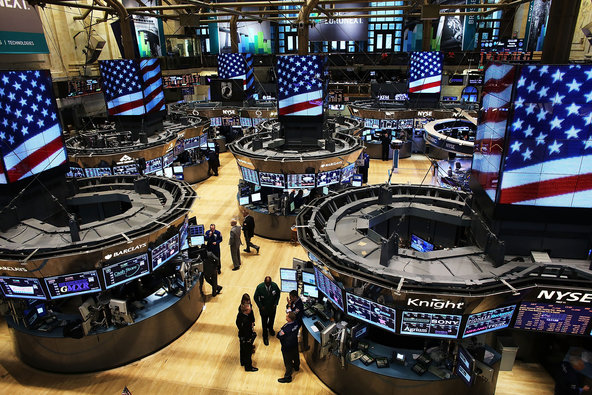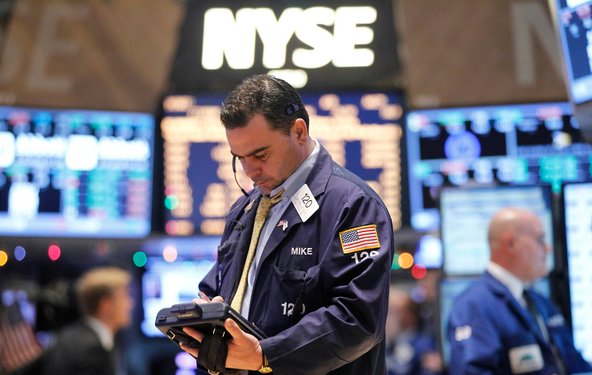 Spencer Platt/Getty ImagesThe floor of the New York Stock Exchange on Thursday.
Spencer Platt/Getty ImagesThe floor of the New York Stock Exchange on Thursday.
On a warm day in Boca Raton, Fla., the host of a reception for an annual financial conference was not a big bank or a powerful exchange as in years past, but a young firm based in Atlanta.
Guests who gathered at the oceanfront resort were surprised. They were greeted with bottled ice water that carried the company’s logo, and as they left, were invited to grab iPod Shuffles.
That event, some four years ago, was the Wall Street equivalent of a coming-out party for the firm, IntercontinentalExchange, or ICE, an electronic operator of markets for derivatives and commodities. Now, the markets upstart is announcing itself to a much larger world with an $8.2 billion deal to buy the symbolic cradle of American capitalism, the New York Stock Exchange.
Related Links
The takeover illustrates starkly how trading in commodities and derivatives has become much more lucrative than trading in the shares of companies. Warren E. Buffett warned in 2003 that the “derivatives genie is now well out of the bottle,” and that the genie, even after a global financial crisis, was not going back. Currently, derivatives — financial bets tied to underlying assets like oil prices or interest rates, among other things — are a $600 trillion market. Even the parent of the N.Y.S.E. attracted its suitor largely because of its ownership of Liffe, a major derivatives exchange in London.
For many, the Beaux-Arts New York Stock Exchange, and images of traders looking despondent or exuberant on its floor, represent what making money is all about. Yet Wall Street itself has found it more profitable to bet on fluctuations in natural gas or corn or on interest rates. The financial industry often does so electronically and through platforms in cities as scattered as London, Chicago and Atlanta. The biggest bonuses each year are typically for traders who reaped rich gains on these often complex financial products.
That change, decades in the making, has left the New York exchange, with roots going back 220 years, in an increasing difficult position as trading volumes slump and profit margins stay razor thin. While its acquirer has pledged to keep a dual headquarters in the exchange building in Lower Manhattan, as well as in Atlanta, the center of power in finance long ago migrated elsewhere.
The success of the newly combined companies hinges on the derivatives business. ICE is hoping that a greater share of derivatives trading will go through its clearinghouse operations, which act as backstops in case one party defaults. It is being aided by the Dodd-Frank financial regulatory overhaul, which is forcing Wall Street banks to push their derivatives trades into clearinghouses and regulated exchanges.
“For the past decade, our solutions made our markets increasingly electronic and increasingly clear,” Jeffrey C. Sprecher, chief executive of ICE, said this month. “Today, financial reform is imposing that vision on many markets through a rule-making process.”
While Dodd-Frank compliance is still in its early days, and the volume of derivatives trading remains depressed amid broader economic uncertainty, the law is ultimately expected to cement ICE’s business model into the regulatory code.
“Despite the complaints, there’s no question that at the end of the day, Dodd-Frank will be a financial boon to exchanges,” said Bart Chilton, a Democratic member of the Commodity Futures Trading Commission, which regulates derivatives.
Still, such a development will not do much for the traditional business of the New York Stock Exchange. Mr. Sprecher said on Thursday that he was committed to keeping the floor of the exchange open. But according to people briefed on his plans, he intends to use the stock trading operation and its steady cash-generating abilities to finance future deals and expansion efforts.
Nowhere have the changing fortunes of ICE and the parent of the New York exchange, NYSE Euronext, been more apparent than in their value on the stock market. In April 2011, when ICE first tried to acquire NYSE Euronext in league with Nasdaq OMX, it was worth about $1.5 billion less than the New York company. Just over a year later, ICE was worth nearly $4 billion more than NYSE Euronext, even with less than a third of its revenue.
ICE was founded in 2000 by Mr. Sprecher, who began his career developing power plants. In the 1990s, he saw that many power companies and financial firms wanted to hedge their investments in energy with financial contracts, but the market for these contracts was disorganized and opaque.
Mr. Sprecher bought an obscure exchange for buying and selling electricity in Atlanta and turned it into ICE with financing from BP and Wall Street firms, including Goldman Sachs and Morgan Stanley.
Banks were drawn to the idea of a standardized place to buy and sell derivatives tied to the value of oil and other commodities. But they also hoped to create a competitor to the virtual monopoly position being built up by the Chicago Mercantile Exchange in futures trading.
“You talk to people in Chicago, they basically think that ICE is just a front for the banks,” said Craig Pirrong, an expert in futures trading and director of the Global Energy Management Institute at the University of Houston.
As the company grew through a quick series of acquisitions, Mr. Sprecher won a reputation for being the “enfant terrible” of the energy industry, with a “sharp eye for identifying opportunities and seizing on them in a very aggressive way,” Dr. Pirrong said.
Early on, ICE sought to move all trading onto computers, allowing firms to buy and sell contracts 24 hours a day. Soon after buying the International Petroleum Exchange in London, ICE shut down its trading floor.
“They were a technology company from Day 1,” said Brad Hintz, an analyst with Sanford C. Bernstein.
ICE also decided to fashion its own clearinghouse, rather than tap an outsize firm. It expanded through acquisitions, planting the seeds for growth in 2008, when it took over the Clearing Corporation, home to a popular derivative known as a credit-default swap.
The Dodd-Frank overhaul may provide additional benefits for ICE. Under the law, exchanges must turn over public and private information to outside data warehouses, which will, in turn, share the information with regulators. Sensing an opportunity, ICE created its own warehouse, named ICE Trade Vault.
ICE and its Chicago rival, CME Group, have also moved in recent months to convert swaps trades, which are facing more scrutiny under Dodd-Frank, into old-fashioned futures contracts. Futures trading is lucrative territory for the exchanges in part because they can shut out competitors.
“The reality is that there are incentives to convert swaps into futures, where there’s less competition,” said Richard M. McVey, chief executive of MarketAxess, an independent trading platform that is expanding into the swaps business. “There’s no requirement for CME and ICE to open their futures clearinghouses to other exchanges.”
Despite its growing prominence, ICE has a small footprint in Washington. With only two full-time lobbyists, the company relies on Mr. Sprecher to communicate with regulators.
“Jeff is the company,” one official said, though others said he had loosened his grip over the last year or so.
He is well received, officials say, in part because he has embraced some reforms. Unlike executives of other exchanges and financial firms, Mr. Sprecher did not resist an effort in 2009 by the Commodity Futures Trading Commission to close certain loopholes.
Officials recall him saying, “Tell me what the rules are, and I’ll make money with them.”
Michael J. de la Merced contributed reporting. Spencer Platt/Getty ImagesTraders on the floor of the New York Stock Exchange.
Spencer Platt/Getty ImagesTraders on the floor of the New York Stock Exchange.
Article source: http://dealbook.nytimes.com/2012/12/20/exchange-sale-reflects-new-realities-of-trading/?partner=rss&emc=rss
